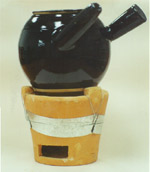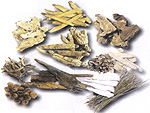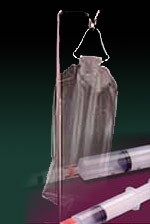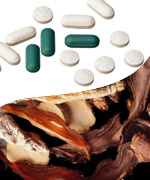From Ancient Times to Modern Day: The Evolution of Preparing Traditional Chinese Medicine
 As society progressed, ancient Chinese philosophies such as yin yang and five elements theories were integrated with TCM practices. A Chinese herbal encyclopedia called the Shennong Bencaojing (Classic of Herbal Medicine) was developed as early as the Han Dynasty (206BC- 220AD), and marked the beginning of an established Chinese medicine system. The experience of TCM practitioners in treating diseases was handed down verbally from one generation to another. TCM physicians would travel to local villages treating patients who needed medical attention. Their duties included gathering medicinal substances, making prescriptions, and dispensing theses preparations to the villagers.
As society progressed, ancient Chinese philosophies such as yin yang and five elements theories were integrated with TCM practices. A Chinese herbal encyclopedia called the Shennong Bencaojing (Classic of Herbal Medicine) was developed as early as the Han Dynasty (206BC- 220AD), and marked the beginning of an established Chinese medicine system. The experience of TCM practitioners in treating diseases was handed down verbally from one generation to another. TCM physicians would travel to local villages treating patients who needed medical attention. Their duties included gathering medicinal substances, making prescriptions, and dispensing theses preparations to the villagers.
The mastery of fire and pottery revolutionized Chinese medicine; because, it allowed herbs to be cooked at different temperatures using a pot. The most common and easiest traditional processing method of Chinese medicine was decoction. Decoction is the process by which herbs are boiled and the remaining liquid is used for health purposes.
Although the real inventors of decoctions were ordinary villagers who experimented with cooking soups, they are recorded as having been invented by Yi Yin. By helping Cheng Tang defeat Xia Jie in the16th century B.C, Yi Yin became the prime minister of the Shang Dynasty. He was well known for his culinary skills, which he then applied to gathering herbs and preparing complex decoctions. Today, we credit Yi Yin with improving the decoction method and extending its applications.
How was Traditional Chinese Medicine discovered and applied?
How was Traditional Chinese Medicine discovered and applied? During ancient times (2200 BC), clans were formed to increase man’s survival in the harsh climates in which he lived. In searching for food and struggling against nature, our ancestors accidentally discovered plants were able to alleviate certain kinds of illnesses. It was gradually recognized some plants were poisonous to human beings, while others were beneficial to health. Later, these observations developed into a systematic search for medicinal substances that could and relieve the suffering of the injured and sick. This was the beginning of the discovery and application of Traditional Chinese Medicine (TCM).
The Decoction Method:
Decoctions are characterized by their quick absorption, favorable therapeutic outcomes, and few toxic side effects.  Ingredients of decoctions can be modified, increased or decreased on a daily basis, allowing physicians to tailor prescriptions to a patient’s changing needs. Decoctions are mostly made into oral preparations that are drunk, but they can also be prepared as gargles or external solutions that are applied to the body. The flexibility of ingredients in decoctions is one of the main reasons this method is still used today after thousands of years.
Ingredients of decoctions can be modified, increased or decreased on a daily basis, allowing physicians to tailor prescriptions to a patient’s changing needs. Decoctions are mostly made into oral preparations that are drunk, but they can also be prepared as gargles or external solutions that are applied to the body. The flexibility of ingredients in decoctions is one of the main reasons this method is still used today after thousands of years.
However, decoctions have some inconveniences. They usually cannot be kept for a long time, and must be drunk shortly after being made. Some ingredients which are not water soluble can take hours to extract using this method, and others can turn into a gas and dissipate. Due to the moderate volume of liquid a decoction typically produces, it can be awkward to carry and difficult for children to take since it generally has a bitter taste. Additionally, today’s fast-paced society is not conducive to staying at home and boiling a decoction for several hours, especially if the person is unwell and requires treatment for an extended period. Furthermore, special attention must be paid to how ingredients are added into the decoction in order to get the best result.
Modern Herbal Dosage Forms:
With the advances of pharmaceutical technology, more convenient dosage forms have evolved. At present, dosage  forms of Chinese patent medicines can be classified into two categories. The first category contains traditional dosage forms like pills, powders, semi -fluid extracts, pellets, gelatins, tinctures, syrups, lozenges, and medicated teas, wines, and solutions. The second category consists of new dosage forms developed from modern technological processes and TCM and western medicine principles. These forms include tablets, capsules, soluble granules, suppositories, and intravenous and intramuscular injections. Both categories offer small dosage sizes and good absorption by the human body. These forms are more user friendly; because, they are not cumbersome to carry and can be worked into a busy schedule. Modern herbal dosage forms have played a tremendous role in clinical treatment and resolved such problems as the inconvenience of preparation and administration of decoctions. Swallowing capsules or tablets is often easier for people who cannot drink large volumes of liquid or who do not like the bitter taste of decoctions.
forms of Chinese patent medicines can be classified into two categories. The first category contains traditional dosage forms like pills, powders, semi -fluid extracts, pellets, gelatins, tinctures, syrups, lozenges, and medicated teas, wines, and solutions. The second category consists of new dosage forms developed from modern technological processes and TCM and western medicine principles. These forms include tablets, capsules, soluble granules, suppositories, and intravenous and intramuscular injections. Both categories offer small dosage sizes and good absorption by the human body. These forms are more user friendly; because, they are not cumbersome to carry and can be worked into a busy schedule. Modern herbal dosage forms have played a tremendous role in clinical treatment and resolved such problems as the inconvenience of preparation and administration of decoctions. Swallowing capsules or tablets is often easier for people who cannot drink large volumes of liquid or who do not like the bitter taste of decoctions.
The Complexity of Herbs:
It is important to remember with Chinese medicine that the final dosage form largely depends on the nature of the substances contained within these preparations and how the body absorbs these substances whether it is a decoction preparation or another form such as a capsule or tablet. Traditional Chinese herbal preparations often combine several herbs because they interact with one another in a synergistic way to maintain health. Herbs may be classified as the monarch, minister, assistant and guide depending on their functions. Furthermore, some herbs are added to prescriptions to minimize the side effects of others that are necessary for the overall desired result. There are so many kinds of Chinese medicinal substances with varied natures that how and why they work is not well understood in many cases. This is the reason Chinese and western researchers are studying Chinese herbs to get a better idea of the mechanisms by which they promote health. Their research is also helping manufacturers to be able to provide better quality herbal supplements with improved extraction techniques and quality control standards.
decoction preparation or another form such as a capsule or tablet. Traditional Chinese herbal preparations often combine several herbs because they interact with one another in a synergistic way to maintain health. Herbs may be classified as the monarch, minister, assistant and guide depending on their functions. Furthermore, some herbs are added to prescriptions to minimize the side effects of others that are necessary for the overall desired result. There are so many kinds of Chinese medicinal substances with varied natures that how and why they work is not well understood in many cases. This is the reason Chinese and western researchers are studying Chinese herbs to get a better idea of the mechanisms by which they promote health. Their research is also helping manufacturers to be able to provide better quality herbal supplements with improved extraction techniques and quality control standards.
Emergencies:
 Certain types of Chinese medicine can be used by individuals in emergency situations. Intravenous and intramuscular herbal injections are commonly used in clinics and hospitals throughout China today. There are about ten kinds of injections for treating angina pectoris (a severe constricting pain in the chest that radiates from the heart area to the left shoulder generally due to lack of oxygen of the heart muscle as result of coronary heart disease). Examples of these types of injections include Guan Ning Injection, Guan Shu Injection, Compound Danshen Injection (Injection of Radix Salvia Militiorrhiza), and Chua
Certain types of Chinese medicine can be used by individuals in emergency situations. Intravenous and intramuscular herbal injections are commonly used in clinics and hospitals throughout China today. There are about ten kinds of injections for treating angina pectoris (a severe constricting pain in the chest that radiates from the heart area to the left shoulder generally due to lack of oxygen of the heart muscle as result of coronary heart disease). Examples of these types of injections include Guan Ning Injection, Guan Shu Injection, Compound Danshen Injection (Injection of Radix Salvia Militiorrhiza), and Chua
nxiong Injection (Injection of Ligustici Chuanxiong). Other examples include emergency herbal preparations like Shengmai Injection and Shenmai Injection which are used to treat shock.
Conclusion:
The evolution of traditional Chinese medicine remains an ongoing process. Traditional decocting meth ods and
ods and
modern dosage forms will continue to be used side by side in Chinese medicine as each type of preparation method offers its own benefits. Just as the early Chinese people searched for herbs that were able to cure illness, modern day society will search for an insight into the complex activities of herbs and their health-sustaining properties with scientific research.
References:
| 1. | 李敦清等:《方劑學》,上海 上海中醫藥大學出版社,1990。 |
| 2. | 段富津主編:《方劑學》,上海 上海科學技術出版社,1995。 |
| 3. | 戴昭宇、趙中振主編:《日本傳統醫藥學現狀與趨勢》,北京 華夏出版社,1998。 |
| 4. | 郭天玲、朱華德主編:《現代中醫藥應用與研究大系(方劑)》,上海 上海中醫藥大學出版社,1996。 |
| 5. | 李儀奎主編:《現代中醫藥應用與研究大系(中藥)》,上海 上海中醫藥大學出版社,1995。 |
| 6. | 劉德軍主編:《方劑與中成藥學》,北京 中國中醫藥出版社,1997。 |
| 7. | 梁頌名主編:《中藥方劑學》,廣州 廣東科技出版社,1991。 |
| 8. | ZhangEnquin ed., Basic Theory of TCM (1) in a Practical English-Chinese Library of Traditional Chinese Medicine, Publishing House of Shanghai College of Traditional Chinese Medicine, (1990). |
| 9. | Stedman’s Medical Dictionary 27th Ed., Lippincott Williams & Williams, (2000). |
Written By:
Dang Yi
Professor, Beijing University of Chinese Medicine
Ph.D. Beijing Union Medical College
Vice Director, Gourmet Food Institute of Health Care and Nutrition of Beijing
Edited By:
Angela Collingwood, MSN, Chief Editor, Integrated Chinese Medicine Holdings Ltd.
Translated by:
Michael Yang
